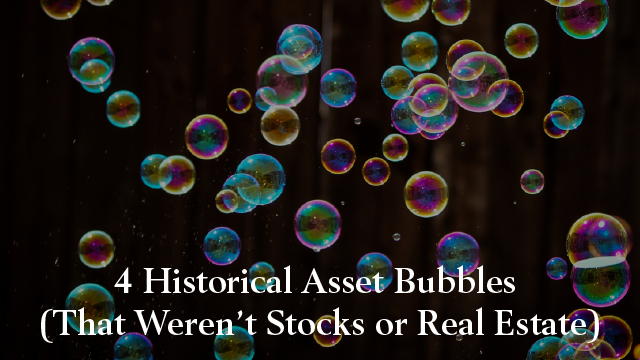
Asset bubbles are nothing new. Real estate and stock market bubbles get the most press, as they cast the widest net in terms of damage when the fun stops, but less traditional assets have also had their own boom-bust cycles. A few months ago, we compared NFTs to the Beanie Baby hysteria from the early 2000s, but here are four more assets that had fervorous spikes in value, only to come crashing down.
The Great Rice Bubble (2008)
A lot of problems were happening in 2008, so it’s understandable that rice isn’t the first thought to come to mind. While the real estate crisis and the recession were the biggest issues on American shores, a simple ruling in India was the first die cast which caused a major bubble in the rice market.
Balking at high wheat prices in late 2007, Indian officials decided to buy more rice. To ensure cheap rice was readily available within the country, it made exporting Indian rice illegal. The effects were felt immediately. Worldwide prices of rice increased the very next day due to fear that there wouldn’t be enough supply[1]. Other countries began to follow India’s lead, restricting exports. In countries like the Philippines, a major importer, the government told citizens flat out to eat less rice. This prompted a frenzy with the general population believing a rice apocalypse was on the horizon.
With fear came hoarding. It’s the hoarding that caused the problem[2].
Rice, especially in Asia and more developing countries, is often government controlled. Its price moves independent of other commodities. Overall, households didn’t hoard much individually, but collectively it added up. The price for a ton of rice went from $300 to $1,200 on the world market.
The punchline to this story is that none of it needed to happen. India’s decision to limit exports of rice didn’t mean there wasn’t any more rice left in the world. There was plenty. The simple fact is fear kept rice off the market and fear caused prices to quadruple.
Eventually a deal was struck that would allow Japan to export excess rice it received from the U.S. to the Philippines, cooling the market off. Hoard behavior is often behind price in these types of historical asset bubbles, as we’ll see later.
The ‘90s Comic Book Bubble (1993)
The initial catalyst for this bubble can be drawn from the same source as Beanie Babies – scarcity. But not intentionally.
During World War II, the nation was forced to ration goods for the war effort, including paper that comics were printed on. The World War II era was also when today’s most popular superheroes were introduced – Superman and Batman being the biggest names. Forty years later, first run editions of those stories in mint condition, Action Comics #1 and Detective Comics #27 respectively, were a rare find, fetching millions from collectors. Other issues featuring well-known characters could sell for thousands. Just like Beanie Babies a few years later, the public began buying up comics as investments, failing to realize the underlying reason why those first run comics were so valuable to begin with.
Collecting comics became an industry all to itself with publishers feeding the beast. “Variant” comics started to be published, books with an artificial change usually involving the cover. A holographic cover, an embossed cover, covers that changed based on body heat[3] – all with limited runs. Speculators could look up the value of their variant in magazines dedicated to covering the prices of specific comics as prices fluctuated. Sounds a lot like a stock market, doesn’t it?
In 1992, a comic could be published at its original price of around $1 and see its value shoot up to $15 or $20 a few months later. By 1993, the industry became so diluted, and prices so high, that it drove away customers. Sales had dropped 70%, comic book stores closed, smaller publishers went out of business, and even Marvel, one of the two largest comic book publishers, filed for bankruptcy at the end of 1996[4].
Financial ruin caused Marvel to sell off the movie rights of its most popular characters just to keep the lights on. Spider-Man, the X-Men, the Fantastic Four, among others were auctioned off, leaving Marvel to work with a bunch of characters that nobody cared about – Iron Man, Captain America, The Avengers… who would ever want to watch a movie about those guys?
Silver Thursday (1980)
Conspiracy theorists often rave that the markets are controlled by a shadowy cabal who are pulling the market strings for their own personal gain, presumably while smoking cigars and wearing Eyes Wide Shut masks. On the silver market in the late 1970s, there was an ominous “They” scheming to pull the strings – the Hunt brothers. They failed and the result was Silver Thursday.
March 27, 1980 – The day that silver prices plummeted.
Nelson Bunker Hunt, William Herbert Hunt, and Lamar Hunt, sons of billionaire oil tycoon H.L. Hunt, claimed that the massive amounts of silver they had accumulated throughout the 1970s using their massive family fortune was not an attempt to corner the market. No, they claimed it was a hedge against the extreme inflation of the decade and the U.S. dollar. By the 1980s, the Hunts owned roughly two thirds of all privately held silver in the world[5], as well as having invested in the futures contracts that went with it.
Persistent buying of silver pushed the price steadily upwards. From under $7 per ounce a year before, the price of silver shot up to $49.45 per ounce at its peak[6].
Trouble started when their inheritance money started to run out. As they wanted to keep buying silver, the brothers started borrowing money to do so. The family name carried enough clout that the brothers could do so at below market rates. They convinced outside investors to pour their money into silver too. Sensing silver prices were overvalued, traders started to short sell silver, but the prices just kept going up. Traders were forced to cover the short positions at major losses. Regular folks even jumped on the bandwagon, hocking anything and everything that contained silver.
And then Uncle Sam entered the fray.
The U.S. government deemed the Hunts were trying to manipulate the market. It enacted a new rule, Silver Rule 7, which restricts the margin requirements for futures contracts on silver. Silver prices sagged and the Hunts were unable to meet their margin calls, forcing them to sell. The selloff started on that fateful Thursday. Only two years later the price of silver would drop 90%, less than $5 per ounce.
Tulipmania! (1634)
And we save the first for last. The Dutch tulip market is often cited as the first asset bubble[7], dubbed tulip mania.
Tulip bulbs made their way to Europe in the 16th century, carrying with them the same mystified exoticism as spices and rugs from the Far East. Their market was based purely on the fact that they looked gorgeous in the garden. It became known that anyone who was anyone had a garden full of tulips. If they didn’t, well, best not to associate with those kinds of people. In time, the Dutch middle class, desperate to be seen as equal to the upper crust, began to demand tulips.
While demand was high, tulips are very fragile. Ramping up supply was difficult as tulips themselves became too difficult to transport and maintain. As a result, the bulbs became a hot commodity. Prices spiked between December 1636 and February 1637 by as much as 1,200%, 200 guilders per bulb. That’s up from only a few guilders four months previously. There are stories of buyers paying as much as 5,000 guilders, the price of a nice house, for one bulb, though that was not the norm[8].
Like the Hunt brothers 300 years later, much of the buying of tulips was done with borrowed money. When the restrictions on lending were tightened, the market for tulips crashed back down to their pre-bubble prices by May 1636.
Conclusion
There have been 400 years’ worth of asset bubbles, frenzies, fads, and manias. No doubt there will be more in the future. Betting on assets whose values soar based on conjecture, fear, or just wish fulfillment is often a losing proposition. Did it happen? Was it real? Yes, but when the bubble bursts, it can lead to losses that never return. The past can hurt – either run from it or learn from it. Rafiki from The Lion King said that. Just because the words came from a fictional cartoon monkey doesn’t mean they’re not true.
Joe Gallina
 Joe has a degree in Finance from the University of Illinois at Chicago. Afterwards, he worked for Morgan Stanley and Bank of America/Merrill Lynch, obtaining both Series 7 and 66 licenses. At Merrill, he was on the self-directed side of the business, exposing himself to every aspect of the financial services industry.
Joe has a degree in Finance from the University of Illinois at Chicago. Afterwards, he worked for Morgan Stanley and Bank of America/Merrill Lynch, obtaining both Series 7 and 66 licenses. At Merrill, he was on the self-directed side of the business, exposing himself to every aspect of the financial services industry.
[1] https://www.princeton.edu/news/2015/04/20/rice-crisis-tracking-asset-price-bubble-check-out-line
[2] Hong, H., dePaila, A., Singh, V. (2015) Hoard Behavior and Commodity Bubbles. National Bureau of Economic Research. https://www.nber.org/system/files/working_papers/w20974/w20974.pdf
[3] https://www.cbr.com/bad-90s-comic-book-covers/
[4] https://www.washingtonexaminer.com/weekly-standard/the-crash-of-1993
[5] https://priceonomics.com/how-the-hunt-brothers-cornered-the-silver-market/
[6]https://silverprice.org/silver-price-history.html
[7] https://corporatefinanceinstitute.com/resources/knowledge/economics/dutch-tulip-bulb-market-bubble/
[8] https://www.history.com/news/tulip-mania-financial-crash-holland
Copyright © 2022 Protinus. All rights reserved.
